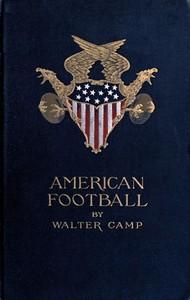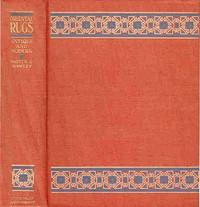|
|
Read this ebook for free! No credit card needed, absolutely nothing to pay.Words: 28681 in 7 pages
This is an ebook sharing website. You can read the uploaded ebooks for free here. No credit cards needed, nothing to pay. If you want to own a digital copy of the ebook, or want to read offline with your favorite ebook-reader, then you can choose to buy and download the ebook. him or shoulder off would-be tacklers. This, to the Englishman, would be the most detestable kind of off-side play, and not tolerated for an instant upon any field in the United Kingdom. Even into this the Americans did not plunge suddenly, but rather little by little they stepped in, until it was necessary to do one of two things--either legalize what was being tacitly consented to, or penalize it heavily. The result was that it was legalized. With this concession, though, there went a certain condition which gained a measure of confidence for the new ruling. To understand just how this state of affairs above mentioned came about one should know that, in the attempt to block opponents when the quarter-back was receiving and passing the ball, the forwards fell into the habit of extending their arms horizontally from the shoulder, as by this method each man could cover more space. For a number of years this went on without detriment to the sport in any way, but after a time there was more or less complaint of holding in the line, and it was ruled that a man must not change his position after the ball was snapped, nor bend his arms about an opponent at such a time. Unfortunately the referee could not watch the ball and the players with sufficient care to enforce this ruling, and the temper of the players suffered accordingly. It is always the case when a rule is not enforced unflinchingly, no matter from what cause, that both sides suffer, and the tendency always is towards devising additional infringements. The additional infringement in this instance was even worse than could have been foreseen; for, not content with simply blocking or even holding an opponent until the quarter should have passed the ball in safety, the players in the forward line saw an opportunity for going a step farther, and actually began the practice of seizing an opponent long after the ball had been played, and dragging him out of the way of the running half-back. In the thick of the rush line this was frequently possible without risk of discovery by the referee; and, emboldened by successes of this kind, men would reach out even in the open, and drag back a struggling tackler just as he was about to lay his hands upon the runner. It was this state of affairs which brought up the question, "How much should a comrade be allowed to aid the runner?" American football legislators answered this question satisfactorily, after long discussion, by determining that the runner might be assisted to any extent, provided the assistant did not use his hands or arms in performing this office. The first result of this was to lower the arms of the rushers when lined up, and, in spite of some forebodings, this proved really a benefit to the game. The second result has been to perfect a system of flanking a runner by companions who form almost an impassable barrier at times to the would-be tacklers. At the same time with mention of the solution of this problem, one should also call attention to a menace which threatened American football far more seriously than did this; and that, too, at a time when the sport was by no means so strong in years or popularity as when this later difficulty arose. I refer to the "block game." This method of play, which consisted in a succession of "downs" without advance and without allowing the opponents any chance of securing possession of the ball, proved a means by which a weak team could avoid defeat. The whole object of the match was thus frustrated, the game resulting in no score. To meet this difficulty a rule was introduced making it incumbent upon a side to advance the ball five yards or retreat with it ten in three "downs." If this advance or retreat were not accomplished, the ball went at once into the possession of the opponents. Never did a rule in any sport work so immediate and satisfactory a reform as did this five-yard rule. Within the last few years there has been no important change in the conduct of the American game, nor in the rules. Outside of the above mentioned points of difference between it and the English game, there is only that of the methods of enforcing rules and determining differences. The English have a referee and two umpires, although the umpires are sometimes replaced by touch-judges. The umpires act, as did the judges in our game of ten years ago, as advocates for their respective sides, and it is this advocacy which is causing them to fall into disfavor there exactly as they did here. Touch-judges merely watch the lines of the field, and decide when and where the ball goes into touch. In cases where they are employed, the referee renders all decisions upon claim of the captains. In our method there is a division of labor, but along different lines. Our two officials, the umpire and referee, have their separate provinces, the former ruling upon the conduct of players as to off-side and other offences, while the latter determines questions of fact as to when the ball is held or goes into touch, also whether a goal is kicked or not. As the rule has it, the umpire is judge for the players, and the referee for the ball. END RUSHER It seems almost unnecessary to say that a high tackler has no chance whatever as an end rusher. He may play guard or centre, but before a man ever essays the end he must have passed through all the rudimentary schooling in tackling, and be such an adept that to pass him without the assistance of the most clever interference is an impossibility. An end should be a good follower; that is, if the runner make in towards the tackle, the end should run him down from behind when interference cuts off the tackle. This is one of the best points for cultivation, because it effectually prevents any dodging by the runner. If he fail to take his opening cleanly, a following end is sure of him. This is not a safe point, however, to teach until the player has fairly mastered the ordinary end-work; for the tendency is to leave his own position too soon, giving the runner an opportunity to turn out behind him, and thus elude the tackle without difficulty. The instructions to the end are to handle the ball as much as possible while the opponent is endeavoring to get it in, and thus make the work of that individual as difficult as possible; and, secondly, to plant one foot close to the touch line and the other as far out into the field as is consistent with stability, and to maintain that position until the play is over. He must neither try to go forward nor around, but, braced well forward, hold his ground. If he does this, no runner can pass within three feet of the touch line, and outside of that the tackle can take care of him. This player, like the end, should, when the ball is played from a fair, be very loath to plunge forward until the play is located, because in the present stage of development of the game one can be quite sure that the opponents will not play the ball from touch unless they have some definite and usually deceptive line of action. Without such it is by far the better policy to walk out the fifteen paces and have it down. The quarter-back also has work to do upon side-line plays, in assisting at the edge as much as possible. But to return to the end. When his own side have possession of the ball, his play, like that of any other man, must be governed by the character of the intended move, and the knowledge of what this move will be is conveyed to him by the signal. The nearer the play is to his end, the greater is the assistance he can render. There is little need of coaching him to do his work when the run is along his line, nor, in fact, when it is upon his side of the centre. The knowledge of the proximity of the runner stirs him up sufficiently, if he have any football blood in him. The point towards which coaching should be directed and where it is needed is in starting instantly to render assistance when the play is upon the other side of the line. There is no limit to the amount of work an end may perform in this direction. A good end can toss his man back so that he cannot interfere with the play, and then cross over so quickly as to perform effective interference even upon end runs. In "bucking the centre" he can come from behind with valuable weight and pressure. A coach should remember, though, that it will not do to start an end into doing too much unless he is able to stand the work, for an end had better do the work well upon his own side than be only half way useful upon both ends. A tired-out end makes the opponents doubly strong. THE TACKLE Free books android app tbrJar TBR JAR Read Free books online gutenberg More posts by @FreeBooks
: In My Nursery by Richards Laura Elizabeth Howe - Children's poetry; Nursery rhymes@FreeBooksWed 07 Jun, 2023

: Oriental Rugs Antique and Modern by Hawley W A Walter Augustus - Rugs Oriental@FreeBooksWed 07 Jun, 2023
|
Terms of Use Stock Market News! © gutenberg.org.in2025 All Rights reserved.






